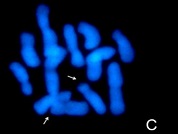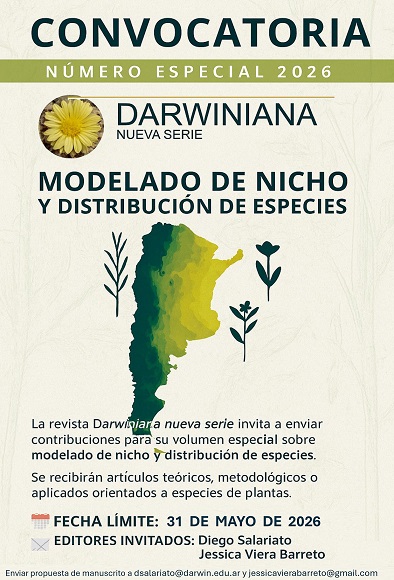Patrones de heterocromatina en cuatro especies diploides de Zephyranthes con diferentes números básicos de cromosomas (Amaryllidaceae)
DOI:
https://doi.org/10.14522/darwiniana.2023.112.1124Palabras clave:
Bandeo cromosómico, cariotipo, disploidía, heterocromatina rica en guanina-citosinaResumen
Diversos cariotipos especie-específicos han sido reportados en Zephyranthes Herb., así como también varios números básicos de cromosomas (x = 5, 6, 7 y 9) aunque el más frecuente es x = 6. El objetivo de este trabajo fue analizar el patrón de heterocromatina constitutiva (C-Het) de los cariotipos de cuatro especies diploides de Zephyranthes. Se presenta por primera vez un análisis citomolecular de los cariotipos de Z. andalgalensis (2n = 2x = 12 = 4 m + 2 sm), Z. chacoensis (2n = 2x = 12 = 3 m + 2 sm +
1 st), Z. robusta (2n = 2x = 12 = 3 m + 2 sm + 1 st), y Z. pedunculosa (2n = 2x = 14 = 1 m + 3 sm + 3 st). Se encontró que todas las especies estudiadas exhiben bandas terminales CMA+ terminal que pueden ser distinguidas por su patrón heterocromático. Curiosamente, también se encontraron bandas intersticiales DAPI+ en el cariotipo de Z. robusta. Los cuatro patrones C-Het de Zephyranthes analizados muestran que las especies diploides tienen poca heterocromatina rica en guanina-citosina, que generalmente se asocia con satélites terminales, y que la heterocromatina rica en adenina-timina es rara. Se discute en el presente estudio el cambio evolutivo disploide entre dos números cromosómicos básicos (x = 6 y 7).
Citas
Acosta, M. C.; E. A. Moscone & A. A. Cocucci. 2016. Using chromosomal data in the phylogenetic and molecular dating framework: karyotype evolution and diversification in Nierembergia (Solanaceae) influenced by historical changes in sea level. Plant Biology 18: 514-526. DOI: https://doi.org/10.1111/plb.12430
Ahmed, L.; R. Begum, S. S. Noor, S. S., M. A. Zaman & S. S. Alam. 2004. Reversible fluorescent chromosome banding in three Crinum spp. (Amaryllidaceae). Cytologia 69 (1): 69-74. DOI: https://doi.org/10.1508/cytologia.69.69
Alam, S. S.; M. Y. Zaman & M. S. Rahman. 2010. Localization of 5S rDNA and 18S-5.8 S-25S rDNA probes in Crinum latifolium L. genome. Bangladesh Journal of Botany 39 (2): 199-205. DOI: https://doi.org/10.3329/bjb.v39i2.7481
Almeida, B. de A.; L. Martins, C. de Almeida Lopes, R. L. Ferreira Gomes, E. dos Santos Valente, A. P. Peron, V. Brito da Silva & L. de Lima Feitoza. 2022. Karyotype polymorphism of GC-rich constitutive heterochromatin in Capsicum L. pepper accessions. Crop Breeding and Applied Biotechnology 22 (1): e38642113. DOI: https://doi.org/10.1590/198470332022v22n1a03
Amaral, A. C. 2011. Habranthus Herb. (Amaryllidaceae) no Brasil: estudo taxonômico, caracterização morfológica e relações filogenéticas. Tesis Doctoral, Universidade de Brasília, Brasilia, pp 1-167.
Arroyo, S. 1990. Habranthus (Amaryllidaceae) en Argentina y Uruguay. Parodiana, 6(1): 11-30.
Arroyo-Leuenberger, S. 2009. Amaryllidaceae. En: R. Kiesling (ed.), Flora de San Juan IV. Mendoza: Zeta Editores, 394-403.
Bacelar, P. A. A.; L. L. Feitoza, S. E. S. Valente, R. L. F. Gomes, L. V. Martins, P. M. Almeida, V. B. Silva, A. C. A. Lopes, R. Carvalho & A. P. Peron. 2023. Variations in heterochromatin content reveal important polymorphisms for studies of genetic improvement in garlic (Allium sativum L.). Brazilian Journal of Biology 83, e243514. DOI: https://doi.org/10.1590/1519-6984.243514
Baeza, C. M.; N. García, F. Herrera, E. Ruiz & M. Rosas. 2017. Chromosomal characterization of Rhodolirium laetum (Phil.) Ravenna (Amaryllidaceae) through karyotyping and in-situ hybridization of ribosomal DNA. Gayana Botánica 74 (1): 240-244.
Barros e Silva, A. E. & M. Guerra. 2010. The meaning of DAPI bands observed after C-banding and FISH procedures. Biotechnic & Histochemistry 85 (2): 115-125. DOI: https://doi.org/10.3109/10520290903149596
Battaglia, E. 1955. Chromosome morphology and terminology. Caryologia 8: 179-187.
Battaglia, E. 1999. The chromosome satellite (Navashin’s ´´Sputnik`` or Satelles): A terminological comment. Acta Biologica Cracoviensia Serie Botanica 41: 15-18.
Brasileiro-Vidal, A. C.; J. A. dos Santos-Serejo, W. D. S. Soares Filho & M. Guerra. 2007. A simple chromosomal marker can reliably distinguish Poncirus from Citrus species. Genetica 129 (3): 273-279. DOI: https://doi.org/10.1007/s10709-006-0007-4
Cage, J. M. 1969. Bigenetic hybrid of Sprekelia and Habranthus. Plant Life 25: 77-78.
Chiavegatto, R. B.; A. L. A. Chaves, L. C. Rocha, F. R. Gandolfi Benites, L. Peruzzi & V. H. Techio. 2019. Heterochromatin Bands and rDNA Sites Evolution in Polyploidization Events in Cynodon Rich. (Poaceae). Plant Molecular Biology Reporter 37: 477-487. DOI: https://doi.org/10.1007/s11105-019-01173-2
Chiavegatto, R. B.; A. Carta, D. G. Pereira, F. R. Benites, V. H. Techio & L. Peruzzi. 2020. Reconstructing ancestral chromosome numbers and inflorescence features in Eleusininae (Poaceae: Chloridoideae: Cynodonteae). Botanical Journal of the Linnean Society 193(3): 402-418. DOI: https://doi.org/10.1093/botlinnean/boaa015
Chowdhury, M. R. & J. Hubstenberger. 2006. Evaluation of cross pollination of Zephyranthes and Habranthus species and hybrids. Journal of the Arkansas Academy of Science 60 (1): 113-118.
Cordeiro, J. M. P.; M. Kaehler, L. G. Souza & L. P. Felix. 2020. Heterochromatin and numeric chromosome evolution in Bignoniaceae, with emphasis on the Neotropical clade Tabebuia alliance. Genetics and Molecular Biology 43 (1): e20180171. DOI: https://doi.org/10.1590/1678-4685-GMB-2018-0171
D’amato, G. F. & G. Bianchi. 1999. The chromosome banding of some Italian Amaryllidaceae. Caryologia 52 (1-2): 87-92. DOI: https://doi.org/10.1080/00087114.1998.10589158
David, J. C. 2011. Nomenclature of intergeneric hybrids of Zephyranthes. Hanburyana 5: 37-46.
Daviña, J. R. 2001. Estudios citogenéticos en algunos géneros argentinos de Amaryllidaceae. Tesis Doctoral, Universidad Nacional de Córdoba, pp 1-184.
Daviña, J. R. & A. Fernández. 1989. Karyotype and meiotic behavior in Zephyranthes (Amaryllidaceae) from South America. Cytologia 54: 269-274. DOI: https://doi.org/10.1508/cytologia.54.269
Daviña, J. R. & A. I. Honfi. 2018. Amaryllidaceae, Habranthus. In: Marhold & Kučera (eds.), IAPT chromosome data 28. Taxon 67 (6): 1235-1245, E1-E2. DOI: https://doi.org/10.12705/676.39
Daviña, J. R.; A. Fernández & A. I. Honfi. 2020. Amaryllidaceae, Zephyranthes. IAPT chromosome data 31/5. In: Marhold, K. & al., IAPT chromosome data 30. Taxon 68: 880, E14-E16. DOI: https://doi.org/10.1002/tax.12176
Daviña, J. R.; A. C. Gianini Aquino, O. A. Rodríguez Mata, E. Tapia-Campos, R. Barba-González & A. I. Honfi. 2022. Chromosomic studies in Zephyranthes citrina Baker (Amaryllidaceae), a polyploid ornamental. Journal of Basic and Applied Genetics 33 (1): 1-7. DOI: https://doi.org/10.35407/bag.2022.33.01.08
Di Fulvio, T. E. 1986. El cariotipo de Habranthus melanopotamicus (Amaryllidaceae). Kurtziana 18: 77-80
Felix, W. J. P.; L. P. Felix, N. F. Melo, J. H. A. Dutilh & R. Carvalho. 2011a. Cytogenetics of Amaryllidaceae species: heterochromatin evolution in different ploidy levels. Plant systematics and Evolution 292 (3-4): 215-221.
Felix, W. J. P.; L. P. Felix, N. F. Melo, M. B. M. Oliveira, J. H. A. Dutilh & R. Carvalho. 2011b. Karyotype variability in species of the genus Zephyranthes Herb. (Amaryllidaceae – Hippeastreae). Plant Systematics and Evolution 294 (3-4): 263-271.
Flory, W. S. 1948. Chromosome studies, and their bearing on phylogeny, in the Amaryllidaceae. Habranthus. American Journal of Botany 35 (10): 791-792.
Flory, W. S. 1968. Chromosome diversity in species and in hybrids, of Tribe Zephyrantheae. The Nucleus 79-95.
Flory, W. S. & R. O. Flagg 1958. A cytological study of the genus Habranthus. The Nucleus 2 (I): 267-280.
Flory, W. S. & G. L. Smith 1980a. High chromosome numbers in several Zephyrantheae taxa. Plant Life 36: 63-71.
Flory, W. S. & G. L. Smith. 1980b. The chromosome of Habranthus martinezii, H. robustus and their f1 hybrid. Plant Life 36: 54-62.
García, N.; A. W. Meerow, D. E. Soltis & P. S. Soltis. 2014. Testing deep reticulate evolution in Amaryllidaceae tribe Hippeastreae (Asparagales) with ITS and chloroplast sequence data. Systematic Botany 39 (1): 75-89. DOI: https://doi.org/10.1600/036364414X678099
García, N.; R. A. Folk, A. W. Meerow, S. Chamala, M. A. Gitzendanner, R. S. Oliveira, D. E. Soltis & P. S. Soltis. 2017. Deep reticulation and incomplete lineage sorting obscure the diploid phylogeny of rain-lilies and allies (Amaryllidaceae tribe Hippeastreae). Molecular and Phylogenetic Evolution 11: 231-247. DOI: https://doi.org/10.1016/j.ympev.2017.04.003
García, N.; A. W. Meerow, S. Arroyo-Leuenberger, R. S. Oliveira, J. Dutilh, P. Soltis & W. Judd. 2019. Generic classification of Amaryllidaceae tribe Hippeastreae. Taxon 68 (3): 481-498. DOI: https://doi.org/10.1002/tax.v68.310.1002/tax.12062
Gianini Aquino, A. C.; A. I. Honfi & J. R. Daviña. 2020. Amaryllidaceae, Habranthus species. In: Marhold & Kučera (eds), IAPT/IOPB chromosome data 33. Taxon 69 (6): 27-29. DOI: https://doi.org/10.1002/tax.12414
Gianini Aquino, A. C. 2023. Niveles de ploidía y modos de reproducción en especies del género Habranthus (Amaryllidaceae) Tesis Doctoral, Universidad Nacional de Córdoba. pp 190.
González, G. E. & L. Poggio. 2021. Intragenomic conflict between knob heterochromatin and B chromosomes is the key to understand genome size variation along altitudinal clines in maize. Plants 2021, 10, 1859. DOI: https://doi.org/10.3390/plants10091859
Greilhuber, J. & Speta, F. 1976. C-banded karyotypes in the Scilla hohenackeri group, S. persica, and Puschkinia (Liliaceae). Plant Systematics and Evolution 126 (2): 149-188.
Guerra, M. 2000a. Chromosome number variation and evolution in monocots. Monocots: systematics and evolution. CSIRO, Melbourne, 127-136.
Guerra, M. 2000b. Patterns of heterochromatin distribution in plant chromosomes. Genetics and Molecular Biology 23: 1029-1041
Guerra, M. 2008. Chromosome numbers in plant cytotaxonomy: concepts and implications. Cytogenetic and Genome Research 120 (3-4): 339-350.
Honfi, A. I.; A. D. Bolzan & J. R. Daviña. 2017. Dimensión Cromosómica. Ciencia e Investigación 67 (1): 5-24.
Howard, T. M. 1990. X Coobranthus coryi TM Howard. A natural bigeneric hybrid of the tribe Zephyrantheae. Herbertia 46 (2): 119-123.
Janssen, A.; S. U. Colmenares & G. H. Karpen. 2018. Heterochromatin: Guardian of the Genome. Annual Review of Cell & Developmental Biology 34: 8.1-8.24. DOI: https://doi.org/10.1146/annurev-cellbio-100617-062653
Khedim, T.; N. Amirouche & R. Amirouche. 2016. Morphological and cytotaxonomic data of Allium trichocnemis and A. seirotrichum (Amaryllidaceae) endemic to Northern Algeria, compared with A. cupanii group. Phytotaxa 243 (3): 247-259. DOI: https://doi.org/10.11646/phytotaxa.243.3.3
Knobloch, I. W. 1972. Intergeneric hybridization in flowering plants. Taxon 21 (1): 97-103.
Las Peñas, M. L.; G. Bernardello & R. Kiesling. 2008. Karyotypes and fluorescent chromosome banding in Pyrrhocactus (Cactaceae). Plant Systematics and Evolution 272 (1): 211-222. DOI: https://doi.org/10.1007/s00606-007-0611-5
Las Peñas, M. L.; J. D. Urdampilleta, B. López-Carro, F. Santiñaque, R. Kiesling & G. G. Bernardello. 2014. Classical and molecular cytogenetics and DNA content in Maihuenia and Pereskia (Cactaceae). Plant Systematics & Evolution 300: 549-558. DOI: https://doi.org/10.1007/s00606-013-0903-x
Las Peñas, M. L.; F. F. Santiñaque, B. López Carro & L. B. Stiefkens. 2016. Estudios citogenéticos y de contenido de ADN en Brasiliopuntia schulzii (Cactaceae). Gayana Botánica 73 (2): 414-420.
Lavania, U. C. & A. K. Sharma. 1983. Chromosome banding and evolutionary plant cytogenetics. Proceeding of the Indian Academy of Science 92: 51-79.
Levan, A.; K. Fredga & A. A. Sandberg. 1964. Nomenclature for centromeric position on chromosomes. Hereditas 52: 201-220.
Lewis, H. 1953. The mechanism of evolution in the genus Clarkia. Evolution 7 (1): 1-20.
Lewis, H. 1973. The origin of diploid neospecies in Clarkia. The American Naturalist 107: 161-170.
Liu, J.; M. Ali & Q. Zhou. 2020. Establishment and evolution of heterochromatin. Annals of the New York Academy of Science 1476: 59-77.
Marinho, A. C.; S. Vasconcelos, E. V. Vasconcelos, D. A. Marques, A. M. Benko-Iseppon & A. C. Brasileiro-Vidal. 2018. Karyotype and genome size comparative analyses among six species of the oilseed-bearing genus Jatropha (Euphorbiaceae). Genetics and Molecular Biology, 41, 442-449. DOI: https://doi.org/10.1590/1678-4685-GMB-2017-0120
Mata‑Sucre, Y.; L. Costa, E. Gagnon, G. P. Lewis, I. J. Leitch & G. Souza. 2020. Revisiting the cytomolecular evolution of the Caesalpinia group (Leguminosae): a broad sampling reveals new correlations between cytogenetic and environmental variables. Plant Systematics and Evolution 306: 48. DOI: https://doi.org/10.1007/s00606-020-01674-8
Meerow, A. W.; E: M. Gardner & K. Nakamura. 2020. Phylogenomics of the Andean Tetraploid Clade of the American Amaryllidaceae (Subfamily Amaryllidoideae): Unlocking a Polyploid Generic Radiation Abetted by Continental Geodynamics. Frontiers of Plant Science 11:582422. DOI: https//doi.org/10.3389/fpls.2020.582422
Mookerjea, A. 1955. Cytology of Amaryllids as an Aid to the Understanding of Evolution. Caryologia 7(1): 1-71. DOI: https://doi.org/10.1080/00087114.1955.10797483
Moscone, E. A.; M. Lambrou & F. Ehrendorfer. 1996. Fluorescent chromosome banding in the cultivated species of Capsicum (Solanaceae). Plant Systematics & Evolution 202: 37-63. DOI: https://doi.org/10.1007/BF00985817
Nandi, S. 1973. Chromosomes studies in several genera of Amaryllidaceae with special reference to the status of the tribe Zephyrantheae. Journal of Cytology and Genetics 7
Naranjo, C. A. 1974. Karyotype of Four Argentine Species of Habranthus and Zephyranthes (Amaryllidaceae). Phyton 32: 61-71.
Nascimento, T.; R. S. Goncalves, M. Báez, G. Seijo & M. Guerra. 2022. Molecular cytogenetics reveals an uncommon structural and numerical chromosomal heteromorphism in Zephyranthes brachyandra (Amaryllidaceae). Boletín de la Sociedad Argentina de Botánica 57: 39-49. DOI: https://doi.org/10.3897/CompCytogen.v11i3.13418
Perry, C. B. & O. Schrader. 2004. Karyotype analysis of Placea amoena Phil. (Amaryllidaceae) by double fluorescence in situ hybridization. Caryologia 57 (2): 200-205. DOI: https://doi.org/10.1080/00087114.2004.10589393
Peruzzi, L.; I. J. Leitch & K. F. Caparelli. 2009. Chromosome diversity and evolution in Liliaceae. Annals of Botany 103 (3): 459-475. DOI: https://doi.org/10.1093/aob/mcn230
Peruzzi, L. & H. E. Eroğlu. 2013. Karyotype asymmetry: again, how to measure and what to measure? Comparative Cytogenetics 7 (1): 1-9. DOI: https://doi.org/10.3897/CompCytogen.v7i1.4431
Romero Zarco, C. 1986. A new method for estimating karyotype asymmetry. Taxon 35: 526-531.
Sassone, A. B.; A. López, D. H. Hojsgaard & L. M. Giussani. 2018. A novel indicator of karyotype evolution in the tribe Leucocoryneae (Allioideae, Amaryllidaceae). Journal of Plant Research 131 (2): 211-223. DOI: https://doi.org/10.1007/s10265-017-0987-4
Sassone, A. B., D. H. Hojsgaard, L. M. Giussani, J. Brassac & F. R. Blattner. 2021. Genomic, karyological and morphological changes of South American garlics (Ipheion) provide insights into mechanisms of speciation in the Pampean region. Molecular Ecology 30: 3716-3729. DOI: https://doi.org/10.1111/mec.16009
Scaldaferro, M. A.; M. V. R. da Cruz, N. M. Cecchini & E. A. Moscone. 2016. FISH and AgNor mapping of the 45S and 5S rRNA genes in wild and cultivated species of Capsicum (Solananceae). Genome 59 (2): 95-113. DOI: https://doi.org/10.1139/gen-2015-0099
Schwarzacher, T.; P. Ambros & D. Schweizer. 1980. Application of giemsa banding to orchid karyotype analysis. Plant Systematics & Evolution 134: 293-297.
Schweizer, D. 1976. Reverse fluorescent chromosome banding whit chromomycin and DAPI. Chromosoma 58: 307-324.
Singh, B. K. & S. K. Roy 1973. Somatic chromosomes of Zephyranthes Herb. Revista Biologica 9: 141-145.
Souza, G.; O. Crosa & M. Guerra. 2015. Karyological, morphological, and phylogenetic diversification in Leucocoryne Lindl (Allioideae, Amaryllidaceae). Plant Systematics and Evolution 301 (8): 2013-2023. DOI: https://doi.org/10.1007/s00606-015-1216-z
Souza, G.; A. L. Vanzela, O. Crosa & M. Guerra. 2016. Interstitial telomeric sites and Robertsonian translocations in species of Ipheion and Nothoscordum (Amaryllidaceae). Genetica 144 (2): 157-166. DOI: https://doi.org/10.1007/s10709-016-9886-1
Stebbins, G. L. 1971. Chromosome Evolution in Higher Plants. Ed. Arnold, London, 216pp.
Traub, H. P. 1952. Biosystematic Experiments Involving Zephyranthes, Habranthus and Amaryllis. Taxon 1 (8): 121-123.
Vimala, Y.; S. Lavania & U. Chandra Lavania. 2021. Chromosome change and karyotype differentiation – implications in speciation and plant systematics. The Nucleus 64: 33-54. DOI: https://doi.org/10.1007/s13237-020-00343-y
Winterfeld, G. & M. Röser. 2007. Chromosomal localization and evolution of satellite DNAs and heterochromatin in grasses (Poaceae), especially tribe Aveneae. Plant Systematics and Evolution 264: 75-100. DOI: https://doi.org/10.1007/s00606-006-0482-1

Descargas
Publicado
Cómo citar
Número
Sección
Licencia

A partir de 2012, esta obra está licenciada bajo una Licencia Creative Commons Atribución-NoComercial 2.5 Argentina .
Cualquier obra derivada deberá estar previamente autorizada con nota escrita de los editores.







